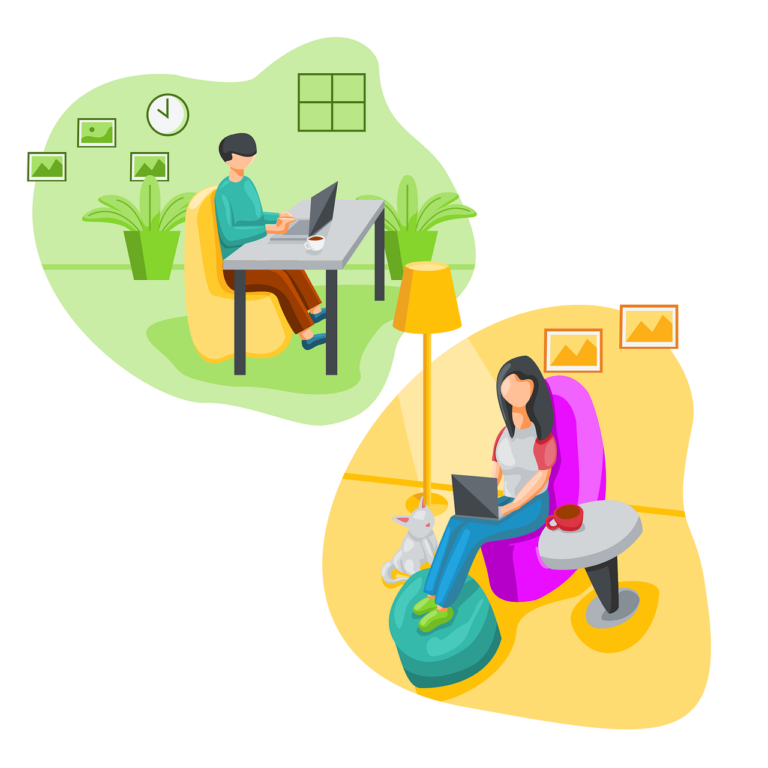In recent years, the landscape of work has undergone a dramatic transformation. The rise of digital nomads and the shift toward remote work have disrupted traditional work structures, creating both challenges and opportunities for businesses and employees alike. This article delves into the trend of remote work, explores its impact on conventional work environments, and discusses the challenges and benefits associated with a more location-independent workforce.
The Emergence of Digital Nomads
Who are Digital Nomads?
Digital nomads are individuals who leverage technology to work remotely while traveling or living in various locations. This lifestyle allows them to maintain their professional responsibilities without being tied to a specific geographic location. Digital nomads often work in fields such as software development, graphic design, writing, consulting, and digital marketing, where physical presence is not a prerequisite for productivity.
The Evolution of Remote Work
The concept of remote work is not new, but it has gained significant traction in recent years due to advancements in technology, the proliferation of high-speed internet, and the growing acceptance of flexible work arrangements. The COVID-19 pandemic acted as a catalyst, forcing many companies to adopt remote work policies. As a result, both employers and employees have become more comfortable with remote work, and many organizations are now considering it as a long-term option.
Impact on Traditional Work Structures
Shift in Organizational Culture
The rise of remote work has necessitated a shift in organizational culture. Traditional office-based work environments are evolving into more flexible and decentralized models. Companies are increasingly focusing on outcomes and productivity rather than the number of hours spent in the office. This shift requires a cultural change where trust, accountability, and clear communication are paramount.
Redefining Workspaces
The traditional office setup is being redefined as more employees work from home or co-working spaces. Companies are re-evaluating their real estate needs and investing in digital infrastructure to support remote work. This shift can lead to cost savings on office space and utilities, allowing businesses to allocate resources more efficiently.
Talent Acquisition and Retention
Remote work has opened up new avenues for talent acquisition and retention. Companies are no longer limited to hiring local talent and can tap into a global talent pool. This flexibility can lead to a more diverse and skilled workforce. Additionally, offering remote work options can be a significant factor in attracting and retaining top talent, as many employees now prioritize work-life balance and flexibility.
Challenges of a Location-Independent Workforce
Communication and Collaboration
One of the primary challenges of remote work is maintaining effective communication and collaboration. In a traditional office, employees can easily interact and exchange ideas. Remote work requires the use of digital tools and platforms to facilitate communication. Companies must invest in reliable communication tools and establish clear protocols to ensure seamless collaboration.
Managing Remote Teams
Managing remote teams requires a different approach compared to traditional office settings. Managers must develop new skills to lead and motivate a distributed workforce. This includes setting clear expectations, providing regular feedback, and fostering a sense of community among team members. Performance metrics should be based on outcomes rather than hours worked.
Work-Life Balance
While remote work offers flexibility, it can also blur the boundaries between work and personal life. Employees may struggle to disconnect from work, leading to burnout. Companies should promote a healthy work-life balance by encouraging employees to set boundaries, take breaks, and prioritize self-care.
Data Security
With employees accessing company data from various locations, ensuring data security becomes a critical concern. Companies must implement robust cybersecurity measures, provide secure access to company resources, and educate employees on best practices for data protection.
Opportunities in the Era of Remote Work
Increased Productivity
Contrary to initial concerns, many studies have shown that remote work can lead to increased productivity. Employees often report fewer distractions and the ability to work during their most productive hours. Companies can leverage this trend by providing the necessary tools and support to enhance productivity.
Cost Savings
Remote work can result in significant cost savings for both employers and employees. Businesses can reduce expenses related to office space, utilities, and commuting. Employees can save on transportation, meals, and work attire. These savings can be reinvested into business growth or employee benefits.
Enhanced Employee Satisfaction
Offering remote work options can lead to higher employee satisfaction and morale. The flexibility to work from anywhere allows employees to better manage their personal and professional lives. Satisfied employees are more likely to be engaged, productive, and loyal to their organization.
Environmental Benefits
Remote work can contribute to environmental sustainability by reducing the need for commuting and lowering carbon emissions. With fewer employees traveling to and from the office, there is a decrease in traffic congestion and pollution. Companies can further their environmental goals by supporting remote work practices.
Real-Life Success Stories
Case Study 1: Automattic
Automattic, the company behind WordPress.com, has been a pioneer in remote work. With a fully distributed team spread across the globe, Automattic has demonstrated how a remote-first approach can lead to success. The company prioritizes communication, collaboration, and employee well-being, setting a benchmark for other organizations.
Case Study 2: GitLab
GitLab, a platform for DevOps lifecycle management, operates entirely remotely. The company has embraced a transparent and flexible work culture, which has allowed it to attract top talent worldwide. GitLab’s extensive remote work guide is a valuable resource for other organizations looking to adopt remote work practices.
Tools and Technologies Empowering Remote Work
Communication Tools
- Slack: For real-time messaging and collaboration.
- Zoom: For video conferencing and virtual meetings.
- Microsoft Teams: For team collaboration and communication.
Project Management Tools
- Trello: For task management and project tracking.
- Asana: For project management and team coordination.
- Jira: For agile project management and issue tracking.
File Sharing and Collaboration
- Google Workspace: For cloud-based productivity and collaboration.
- Dropbox: For file storage and sharing.
- Notion: For all-in-one workspace collaboration.
Future Trends in Remote Work
Hybrid Work Models
As companies continue to adapt to remote work, hybrid models combining in-office and remote work are becoming increasingly popular. This approach offers flexibility while maintaining some level of in-person interaction.
Increased Focus on Employee Well-Being
Organizations are recognizing the importance of employee well-being in a remote work environment. Initiatives such as virtual wellness programs, mental health support, and flexible working hours are gaining traction.
Advanced Remote Work Technologies
Emerging technologies like virtual reality (VR) and augmented reality (AR) are set to revolutionize remote work. These technologies can create immersive virtual workspaces, enhancing collaboration and engagement among remote teams.
Conclusion
The rise of digital nomads and remote work is reshaping traditional work structures in profound ways. While this shift presents challenges, such as maintaining communication and ensuring data security, it also offers numerous opportunities for increased productivity, cost savings, and enhanced employee satisfaction. By embracing the tools and technologies that empower remote work, and by learning from the success stories of companies like Automattic and GitLab, organizations can create a more flexible, efficient, and inclusive work environment. As we move forward, the key to success lies in adaptability, continuous learning, and a commitment to fostering a culture that supports remote work.




